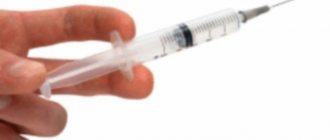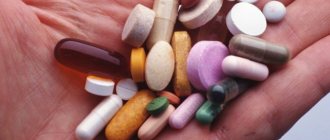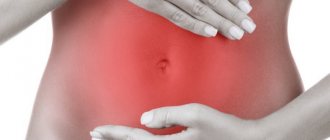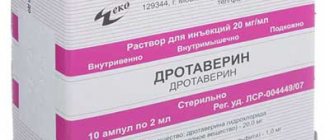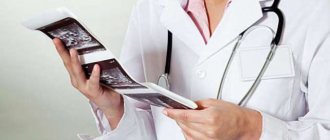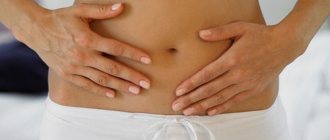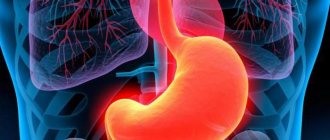No-spa for stomach pain
“Noshpa” is one of the most common medicinal painkillers due to its price and effectiveness. The use of “Noshpa” helps with pain in the abdominal cavity, in particular, it can dull the pain of an ulcer (inflammation of the stomach).
Indications for use of Noshpa for the stomach
“Noshpa” should be used in the following cases:
- increased level of acidity of gastric juice (causes pain and discomfort in the stomach);
- gastritis (chronic/acute);
- poisoning caused by eating poor quality food;
- stress cramps in the stomach;
- ulcer;
- constipation, which causes pain in the stomach and anus;
- inflammatory processes of the gastrointestinal tract;
- mechanical damage to the mucous membranes of the gastrointestinal tract;
- pancreatitis.
Directions for use for pain
The dosage of the drug depends on the age criterion, the nature of the pain, its duration and the strength of the effect. The most optimal is the individual selection of an anesthetic by a qualified specialist. If you cannot see a doctor, remember the following:
- “No-spa” is taken orally, washed down with liquid, which will help the tablet enter the stomach;
- Do not take the medication on an empty stomach (more than 20 minutes should pass after the last meal);
- the maximum amount of painkiller (regardless of dosage) is 300 mg.
Dosage
- Adults: 80 mg; 1-3 times a day.
- Children under 6 years of age: 20 mg; 1 per day.
- Children over 6 years old: 40 mg; 2 times a day.
Side effects
- nausea, vomiting;
- constipation;
- sleep disturbance;
- dizziness;
- a sharp decrease in blood pressure/increase in heart rate;
- an allergic reaction (most often dermatitis) caused by individual intolerance to the substances that make up Noshpa;
- increased sweating;
- difficulty breathing;
- strengthening of pathogenic effects that previously affected the body (up to cardiac arrest);
- edema.
If one of the side effects occurs, you should immediately stop using the drug and consult a doctor. Most often, once you stop taking it, the side effects disappear.
Contraindications
- Individual intolerance to substances included in the drug.
- Severe deformations of the cardiovascular system.
- In case of severe disorders of the renal system.
- The use of Noshpa by infants is contraindicated.
- Low blood pressure.
Use during pregnancy/lactation
Before taking, you should consult your doctor.
If a pregnant/lactating woman has a stomach ache, it is permissible to take “Noshpa” in the amount of 2 tablets per day.
The time frame for such treatment should not exceed 3 days.
It is advisable that the woman consult with her doctor, since pain may indicate more serious disorders in the body that can be dangerous for the baby.
If your stomach hurts after taking the maximum allowable dose of the drug, you should contact an ambulance, stop eating food and do not exercise.
Interactions with other drugs
It is forbidden to drink drugs that envelop the mucous membranes of internal organs simultaneously with “Noshpa”, since the antiseptic and anti-inflammatory effect of the medications is canceled.
It is not recommended to take medications for the treatment of cardiovascular diseases, antibiotics, due to poor absorption and digestibility of medications.
The use of enzyme medicinal substances/anti-ulcer drugs is permitted.
Special Recommendations
Within 1-2 hours after consuming the drug, the patient may experience absent-mindedness, decreased overall physical activity, fatigue, etc. It is recommended to limit the performance of work that requires concentration and heavy physical activity during this period. If the pain does not stop after taking the drug, seek help from a specialist.
Storage recommendations
“Noshpa” should be kept in a dark, dry place where room temperature is maintained. It is not recommended to subject it to mechanical stress, which may damage the integrity of the packaging.
Children's access to medications should be limited. The shelf life of “Noshpa” is 3 years.
Source: https://TvoyZheludok.ru/lechenie/traditsionnoe/no-shpa-pri-boli-v-zheludke.html
Treatment regimens
When the stomach hurts, the two most common therapeutic regimens are used - decreasing or increasing. Using an escalating dosage regimen, medication intake is steadily increased. The first stage of treatment involves dietary nutrition and restoration of the patient’s correct behavior style.
To correct metabolic disorders, proton pump blockers are used. At the same time, antacids are often used, which protect the gastric mucous surface from damage. The dosage of medications is gradually increased, their absorption by the body helps to achieve the desired effect.
For a lowering regimen, it becomes typical to use the maximum dosage of tablets at a very early stage of treatment. When the patient’s stable condition is achieved, his body is completely cleansed of the presence of medications, and the tablets are then taken only in the amount necessary for the supporting effect.
But spa on an empty stomach
“Noshpa” should be used in the following cases:
- increased level of acidity of gastric juice (causes pain and discomfort in the stomach);
- gastritis (chronic/acute);
- poisoning caused by eating poor quality food;
- stress cramps in the stomach;
- ulcer;
- constipation, which causes pain in the stomach and anus;
- inflammatory processes of the gastrointestinal tract;
- mechanical damage to the mucous membranes of the gastrointestinal tract;
- pancreatitis.
No-Spa drug for abdominal pain - description
Effective antispasmodic drugs can have a beneficial effect on various organ systems.
The drug no-spa, which is often used for regular female pain, can also relieve the symptoms of many diseases of the gastrointestinal tract.
The medicine is sold in pharmacies without a prescription, but it is still highly advisable to consult a doctor regarding its use.
What is no-spa intended for? Typically indications for use are:
- cholecystitis;
- cystitis;
- tension headaches;
- dysmenorrhea (heavy menstruation);
- cramp-like abdominal pain due to gastritis, gastric or duodenal ulcers;
- spastic colitis with constipation;
- pancreatitis.
The main contraindications are hypersensitivity to the components, liver, heart and kidney failure. During pregnancy and lactation, no-shpa can be drunk only with great caution - a risk to the baby’s life cannot be ruled out.
These tablets should not be given to children under 6 years of age at all. There have been no clinical studies that would allow an objective assessment of the effect of the drug on the children's body.
Duspatalin and pancreatitis
Pain during inflammation of the pancreas can be pressing, burning, boring, and have a different location.
"Duspatalin" for pancreatitis is used to eliminate pain of varying intensity that accompanies this disease.
In this case, the medication relieves spasms and alleviates the patient’s condition, but it is recommended to use it as prescribed by a doctor and strictly, adhering to the prescribed dosage.
Duspatalin can be used to relieve pain in the gastrointestinal tract due to pancreatitis.
- 1 Composition of the medicine
- 2 Release form
- 3 How does it work?
- 4 Indications and contraindications for the use of Duspatalin for pancreatitis
- 5 How to take?
- 6 Overdose
- 7 Combination with other drugs
- 8 Analogue drugs
Composition of the medicine
The drug "Duspatalin", which is a potent antispasmodic, contains mebeverine as an active substance, as well as the following auxiliary components:
- magnesium stearate;
- potato starch;
- lactose monohydrate;
- sucrose;
- talc;
- triacetin;
- ammonia, aqueous;
- propylene glycol;
- potassium hydroxide;
- titanium dioxide
Effective tablets for peptic ulcers and gastritis
When starting treatment for gastritis, they use antibacterial medications characterized by an enveloping effect. They are prescribed when the process of digesting food is accompanied by painful heartburn. The maximum effect is exerted by tablets that provoke the proliferation of epithelial cells, which have a detrimental effect on bacteria. It is these functions that help to heal emerging wounds as quickly as possible. The following medications are common:
- Arpenal;
- Flacarbine;
- Apilak;
- Famotidine;
- Aprofen;
- Teraflex;
- Amizil;
- Afobazole;
- Iberogast;
- Trichopolum;
- Thiosulfate;
- De-nol;
- Remantadine;
- Loperamide;
- Wobenzym;
- Maalox;
- Detralex;
- Gastrofarm;
- Perfect;
- Anacid;
- Almagel;
- Gastal.
To quickly block severe stomach pain, you should always have No-Shpu, Buscopan, Almagel and Drotaverine in your home medicine cabinet.
You can drink noshpa on an empty stomach
“No-spa” is in every first aid kit and is used as a pain reliever. But “No-shpa” is not an anesthetic, but an antispasmodic. Thanks to the ability to relieve muscle spasm, an analgesic effect is achieved.
It is used for abdominal pain, to relieve coughing, and for painful periods. You need to take pills when you are sure of the exact origin of the pain attack.
Otherwise, taking the drug masks the symptoms of an “acute abdomen” and can lead to the development of complications that threaten the patient’s life.
Gastritis
Compound
The active ingredient is drotaverine in an amount of 40 mg. The tablets contain additional substances presented:
- talc;
- povidone;
- starch;
- magnesium stearate;
- lactose.
If the drug is used in liquid form, in addition to drotaverine, sodium disulfide, ethanol, and injection water are included.
"No-shpa"
How to release
“No-shpa” is produced in solid dosage form and solution for injections. The tablets are yellowish in color, round, convex on both sides. On one side there is a special engraving. When broken, the tablets are homogeneous.
The product has a bitter, tart taste. Tablets are placed in an aluminum blister of 6, 10, 12, 20, 24 pcs. The tablets are placed in paper packs along with instructions for use.
The medicine with a multiplicity of 60, 64, 100 is packaged in plastic bottles with a dispenser in a stopper.
Liquid “No-shpu” for injections is produced in ampoules of 2 ml. The ampoules are made of dark glass, there is a risk and a break point. Ampoules are placed in a plastic tray of 5 pieces. 1 or 2 pallets are folded into a cardboard box along with an annotation. The liquid has a characteristic yellow-green color, transparent, without sediment or flakes.
The medicine is stored out of the reach of children at a temperature not exceeding 25°. Shelf life: 3 years. "No-spa" is available in pharmacies without a prescription.
Pharmacodynamics and pharmacokinetics
Drotaverine, by its nature, is an isoquinoline derivative - it interrupts the chain of transmission of nerve impulses - acts as a powerful antispasmodic, relaxing smooth muscles, eliminating spasms.
Drotaverine relieves spastic phenomena of a muscular and neurogenic nature. The action does not depend on autonomic innervation.
Therefore, it relaxes the muscles of the intestinal tract, genitourinary organs, and bile ducts.
Slightly expands the lumen of capillaries, improving blood supply, preventing hypoxia of spasmodic tissues. The medicine relieves spasms and eliminates pain.
Drotaverine is well and quickly absorbed by the intestinal tract. After entering the body, the product is absorbed by 65%, after an hour it reaches its maximum concentration, has a high ability to bind to blood proteins, and is evenly distributed throughout the muscle tissue.
In small amounts, drotaverine (metabolites) pass through the placenta. Neutralized by liver cells. The half-life is 8-10 hours; after 3 days, no drug residues are detected in the plasma.
“No-spa” is excreted from the body by the kidneys and gastrointestinal tract.
Interesting fact! Drotaverine is excreted from the body in the form of metabolites. Unchanged drotaverine is not detected in urine.
This is important to know
- Acute colitis - drug treatment
- Ulcerative colitis of the intestine - treatment with folk remedies
- Hemorrhoids are bleeding - what to do?
- Hemorrhoids zinc ointment
- How long can remission last for a stomach ulcer?
Scarlet blood from the anus without pain
Yes, bleeding from the anus can be a symptom of hemorrhoids. But also .
Bandage for bowel prolapse
One of the most effective preventive measures for bowel prolapse and others.
Abscess on the tailbone
You write that you fell on your stomach. But the stomach is...
How many days does it take for hemorrhoids to resolve?
How long does it take to treat hemorrhoids with external inflammation? How many days does it take?
Treatment of chronic anal fissure with folk remedies
Among proctological diseases, anal fissure is perhaps the least dangerous ailment. .
What does nagging pain in the anus mean?
Pain in the anal area is a fairly common complaint. The reasons are as follows.
Causes of itching and discharge in the anus
Mucus from the anus is released during infectious diseases, hemorrhoids, and terminal fissures.
Indications and contraindications
Indications for taking No-Spa for conditions that cause spasms of smooth muscles:
- headache caused by vascular spasm;
- peptic ulcer of the stomach and duodenum;
- inflammation of the gastric mucosa of various etiologies;
- pylorospasm;
- gastroenteritis;
- intestinal colic;
- irritable bowel syndrome;
- spastic constipation;
- blockage of bile ducts with stones;
- inflammation of the gallbladder;
- hepatic colic;
- spasm of the sphincter of Oddi;
- inflammatory kidney pathologies;
- urolithiasis;
- renal colic;
- inflammation of the bladder;
- painful periods;
- bloating;
- pain with cystitis.
Conditions when taking No-Spa is contraindicated:
- individual intolerance to the ingredients of the medicine;
- severe liver and kidney pathologies;
- heart muscle failure (low cardiac output) severe stage;
- children under 6 years old;
- galactose intolerance;
- lactation period.
Attention! Requires special caution in childhood, pregnancy, and hypotension.
Causes of a feeling of heaviness in the stomach
Discomfort and a feeling of fullness in the epigastric area occurs when the coordinated functioning of the digestive organs is disrupted. It may be a temporary phenomenon or a signal of diseases of the digestive system.
Heaviness appears in isolation or accompanied by symptoms such as belching, heartburn, nausea, and flatulence.
The reason for the appearance of unpleasant sensations is often overeating, consumption of low-quality or difficult to digest food, fried, fatty foods, smoked foods, soda, as well as a chaotic diet. The causes of heaviness in the abdomen are:
Very important! Savina G.: “I can recommend only one remedy for the quick treatment of ulcers and gastritis” read more.
- gastrointestinal diseases - ulcers, gastritis, pancreatitis, cholecystitis;
- oncological pathologies of the stomach;
- smoking and alcohol abuse;
- pregnancy;
- long-term medication use;
- severe stress;
- functional dyspepsia.
If you experience a regular feeling of heaviness in the stomach after eating, which lasts for more than 3 days, you should definitely consult a gastroenterologist for advice and examination.
Side effects
While taking the drug, undesirable reactions of the body may occur:
- skin rashes;
- tachycardia;
- hypotension;
- dizziness;
- headache;
- insomnia;
- dyspeptic disorders.
This “side” rarely occurs and goes away after discontinuation of the drug.
"Side effect"
Less risk
In some cases, it will be enough to take a pill when there is heaviness in the stomach. These are situations that occur rarely and are not too painful.
Typically, heaviness in the stomach after eating occurs after a heavy meal or a very heavy meal.
But when a person eats right, eats in moderation, and after eating heaviness still occurs - this is a sign of a serious illness; a visit to a therapist or gastroenterologist cannot be postponed.
You should not rely on the opinion of the pharmacist at the pharmacy about which pills to take: a pharmacist is not a doctor. Even a doctor recommends medications only after identifying the cause of poor health, examination and diagnosis.
Heaviness in the stomach after eating can occur for a number of reasons, depending on which the drug for treatment is selected. And you need to take it strictly according to the plan.
However, there are a number of drugs aimed at eliminating the severity, but not at treating the underlying disease.
Dosage for gastritis
To relieve spasms of the muscles of the intestinal tract that occur against the background of gastritis, antispasmodics are used. “No-shpa” has become popular and relatively inexpensive. Quickly relieves an attack, after 20 minutes the patient feels relief.
To relieve a painful attack of gastritis, tablets are used and injections are given. The doctor chooses the form of the medicine. But, “No-spa” relieves the symptoms, the cause of the disease remains.
Therefore, it is used as an “ambulance”, as part of complex therapy.
Pills
The maximum dose for adults is 6 tablets (240 mg). It should not be exceeded due to the increased risk of adverse reactions. The standard therapeutic dosage corresponds to 1-2 tablets 2-3 times a day. The drug is drunk half an hour before meals (30 minutes after). The medicine is not taken on an empty stomach to avoid injury to the gastric mucosa.
Therapy for children 6-12 years old involves taking 1 tablet 2 times a day. Maximum - 2 tablets. Children over 12 years old can take no more than 4 tablets per day.
This therapy is carried out for no more than 2-3 days. If there is no improvement, you should stop taking the medication and consult a doctor. You should also do this if there is no positive result after taking the maximum daily dose of the drug.
